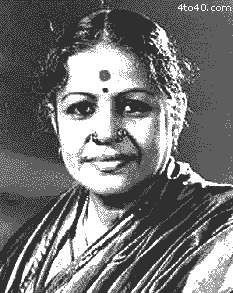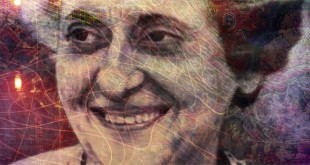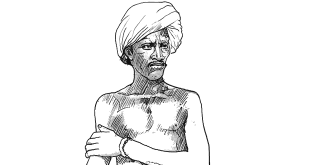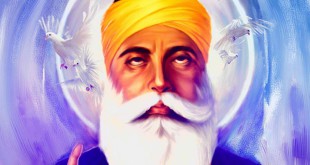 Madurai Shanmukhavadivu Subbulakshmi (M.S. Subbulakshmi), the nightingale of Carnatic music was born in Madurai, Tamil Nadu on September 16, 1916 to noted Veena player Shanmukhavadivu and lawyer Subramania Iyer.
Madurai Shanmukhavadivu Subbulakshmi (M.S. Subbulakshmi), the nightingale of Carnatic music was born in Madurai, Tamil Nadu on September 16, 1916 to noted Veena player Shanmukhavadivu and lawyer Subramania Iyer.
Young Kunchamma as she was called and her siblings was brought up in a musical environment in her home close to the Madurai Meenakshi Temple. Her grand mother Akkammal was a violinist. Her mother used to play and rehearse constantly and Kunchamma used to listen and hum ragas along with the Veena and the Nadaswaram recitals frequently heard from the temple. Her first Guru was Madurai Srinivasa Iyengar but her lessons could not last long as her guru passed away soon after she finished her foundations. But she kept practicing on her own for long hours. She did her formal schooling only till class 5th and music became the world for her. Subbulakshmi’s perfect pitch whether high or low and fantastic range of voice is the result of her dedication, toil and hours of continuous practice. As a child, when she practiced she would stop playing the tambura in between to check whether she is maintaining the pitch with and without it. She also learned Hindustani music from Pandit Narayan Rao Vyas for a short while. In the 1930’s she learned ‘khayals’ and ‘thumris’ from Dwijenderlal Roy in Calcutta and later from Siddheshwari Devi of Benares and bhajans and Rabindra Sangeet from Dilipkumar Roy, she incorporates bhajans in almost all her concerts.
Little Kunchamma accompanied her mother in local concerts and later gave solo performances. She was the child prodigy of Madurai at one time. Her first recording was at the age of ten, when she recorded a couple of songs ‘Marakat vadivu’ and ‘Oothukuzhiyinile’ in an impossibly high pitch for HMV in Madras. In 1934, in her debut at the Madras Music Academy she was noticed and applauded by top rank musicians like Chembai Vaidyanatha Bhagavathar, Tiger Varadachariar, Karaikudi Sambavisa Iyer and the likes.
In 1940 she married Thiagaraja Sadasivam, a well known figure in the Madras Congress circle, at Thiruneermalai. They had met four years earlier and with his wide connections in the journalistic and political world, he became instrumental in the continued success of her already flourishing career. From 1938 for a period of six years she started acting in films for a short while. Her films were quite successful but later in 1944 after her big hit ‘Meera’ produced by her husband and released in Tamil and Hindi, she quit and concentrated solely on music. From a South Indian celebrity she went on to become a national figure. Internationally she has given concerts almost all over the world like at Edinburgh festival and at the United Nations (1970), Carnegie Hall as the inaugural concert of the festival of India in London in 1982.
Subbulakshmi has been the recipient of the highest awards and honours the nation could bestow upon an artist and significant international recognition. She has earned doctorates from famed universities and her divine voice has earned acclaim from big and famous personalities like Mahatma Gandhi, Pandit Jawarharlal Nehru, Maharana of Udaipur etc as well as top rank musicians both in the Carnatic and Hindustani sphere in the country. In 1998, she was the first musician to receive the highest civilian award ‘Bharat Ratna’ from the President of India. Padma Bhushan (1954), Padma Vibhushan (1975), Ramon Magsaysay award (1974) are some of the major awards she has received.
The world of fame and adoration of thousands of fans, has left Subbulakshmi untouched. She remains the simple, neat, devout, down to earth person she always was and having a genuine interest in others. She passed away at the age of 88.
Madurai Shanmukhavadivu Subbulakshmi (September 16, 1916 – December 11, 2004) was a renowned Carnatic vocalist. She was the first musician ever to be awarded the Bharat Ratna, India’s highest civilian honor.
Singing Career
M. S. Subbulakhsmi was born to a musical family, in the temple town of Madurai, situated in the state of Tamil Nadu in South India. M.S. started learning Carnatic music from a very early age and released her first recording at the age of 10. She then began her Carnatic classical music training under Semmangudi Srinivasa Iyer and then Hindustani classical training under Pandit Narayan Rao Vyas. At 17, the child prodigy made her debut at the Madras Music Academy. Since then, she performed countless musical forms in different languages such as Hindi, Bengali, Gujarati, Tamil, Malayalam, Telugu, Sanskrit and Kannada.
M.S. became famous as a film actress. Her most memorable role was Bhaktha Meera in Meera (1945). The movie had M.S. sing the famous Meera bhajans, with Dilipkumar Roy as the music director. Those renditions by M.S. continue to enthrall listeners to this day. Following the success of the film she quit films and turned wholly to concert music.
M. S. met Sadasivam, a freedom fighter, and a follower of Rajaji, in 1936. She married him in 1940 and their marriage spanned over 50 years. They had no children. Sadasivam had children from his previous marriage that M.S. treated as if they were her own children. They were named Radha, Viji, and Sadasivam’s niece Thangam, who was orphaned at a young age and was raised by Sadasivam and M. S. Radha frequently sang with M.S. in concert while Vigi played the sitar. They lived in a mansion named “Kalki Gardens”, and as Radha, Viji, and Thangam grew up, their children also lived in the mansion with M. S., or as they affectionately called her, Amu Patti.
M. S. travelled to London, New York, Canada, the Far East, and other places as India’s cultural ambassador. Her concerts at Carnegie Hall, New York; the UN General Assembly on UN day in 1966 (while U Thant was the Secretary General); the Royal Albert Hall, London in 1982; and at the Festival of India in Moscow in 1987 were significant landmarks in her career.
As a first-time foreign listener put it, “M. S. does not sing. She makes divinity manifest.”
Mahatma Gandhi was so charmed of her Meera bhajans that he requested her to sing the song Hari Tum haro Jan ki bheer (Lord, please dispel the fear in mankind). She regretfully declined as she had a cold that day. A prompt reply came back from the mahatma’s side saying “I would gladly hear subbulakshmi speak it than hear it sung by others”.
In the late 1950s, as she sang at the Ramakrishna Ashram in Delhi, Pandit Jawaharlal Nehru, India’s first prime minister, was among the audience. At the end of the recital he was so moved that he bowed, and said, “What am I, a mere prime minister before a queen of music (he was to repeat it in every speech of his, praising her).”
Not unexpectedly, “she talks, sings and lives music twenty-four hours a day,” and is deeply religious. The puja (prayer) room in her house has three life-size portraits of Sri Chandrashekarendra Saraswati Sankaracharya, the saint whom she calls “divinity in flesh and blood,” and who has “been instrumental in restoring the faith and religious temperament of the people of Madras and reclaiming many to the path of God” in recent years. As her guru, he selected the verses for the highly popular record she made in 1970 of the Bhajagovindam (some 30 verses composed by the poet-philosopher Sankara in praise of Lord Krishna, which are both musical and of much philosophical content) and Vishnu Sahasranamam (a musical chant of the 1,000 names of Vishnu, one of the three main gods of the Hindu pantheon).
Honours and Awards
While Lata Mangeshkar called her Tapaswini (the Renunciate), Ustad Bade Ghulam Ali Khan termed her Suswaralakshmi (the goddess of musical notes), and Kishori Amonkar labeled her the ultimate eighth note or Aathuvaan Sur, which is above the seven notes basic to all music. Her many famous renditions of bhajans include the chanting of Bhaja Govindam, Vishnu sahasranama (1000 names of Vishnu) and the Venkateswara Suprabhatam (musical hymns to awaken Lord Balaji early in the morning).
She was widely honored, praised and awarded. Some of them more popular ones include Padma Bhushan in 1954, Sangeetha Kalanidhi in 1968 (literally, Treasure Chest of Music. She was the first woman recipient of the title), Ramon Magsaysay award in 1974, the Padma Vibhushan in 1975, the Kalidasa Sanman in 1988, the Indira Gandhi Award for National Integration in 1990, and the Bharat Ratna in 1998. She was also honored as the court-singer of Tirumala Tirupati Devasthanams.
Although she was bestowed with enormous prize moneys on these awards, she donated most of them to charity.
She was an ardent devotee of Kanchi Mahaswamigal and she rendered his composition Maithreem Bhajatha (O World! Cultivate peace) in her concert at the UN in 1966. She donated many of the royalties on several best sold records to many charity organizations.
With the death of her husband Sadasivam in 1997, she stopped all her public performances. M.S. died on December 11, 2004 after a brief illness, due to complications relating to pneumonia and cardiac irregularities.
 Kids Portal For Parents India Kids Network
Kids Portal For Parents India Kids Network






